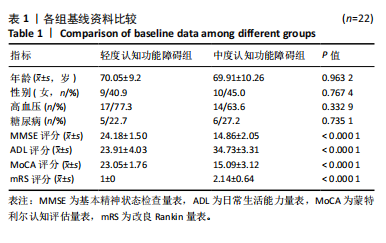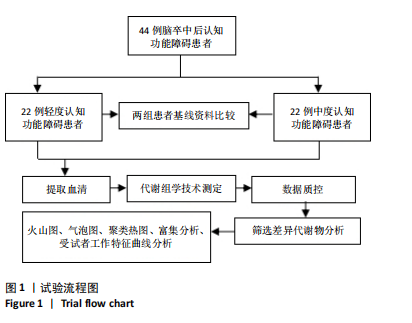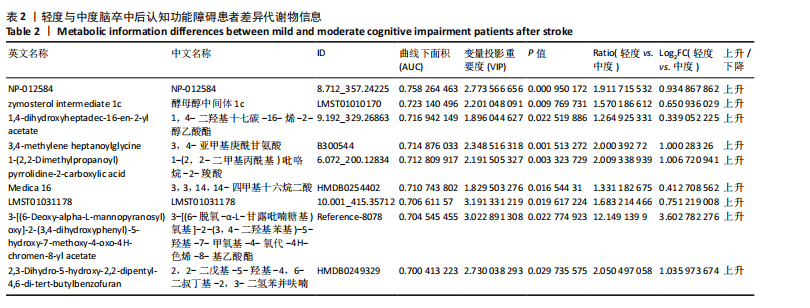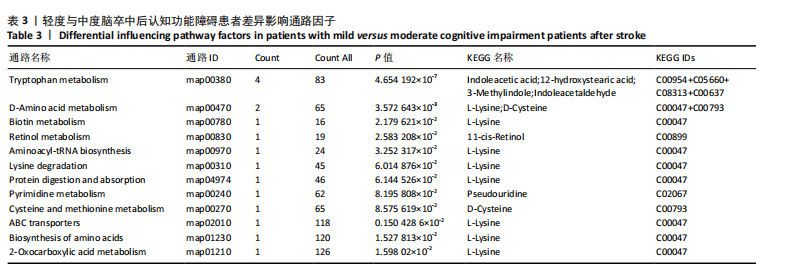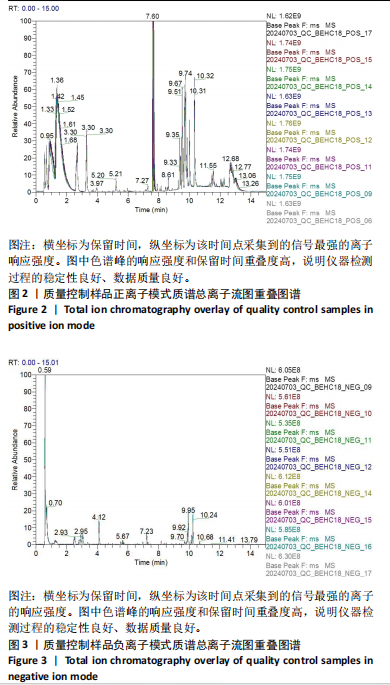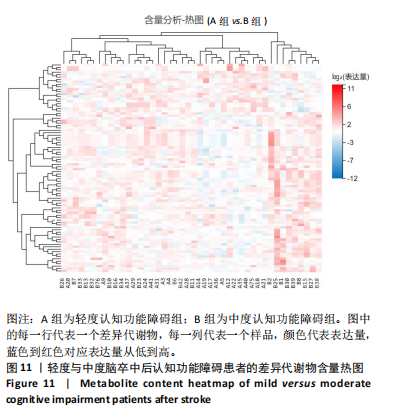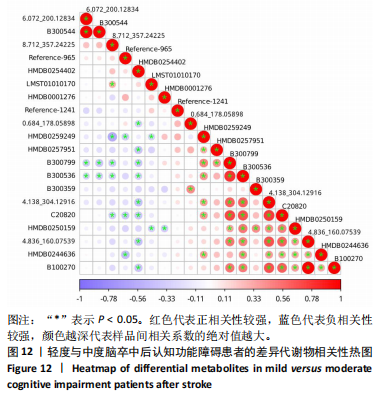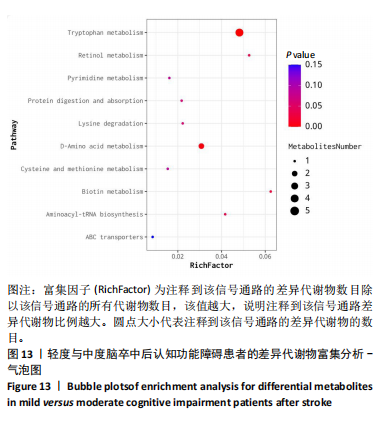[1] 吴永亚,边红.脑卒中后认知功能障碍研究进展[J].神经病学与神经康复学杂志,2020,16(1):34-40.
[2] HUANG YY, CHEN SD, LENG XY, et al. Post-Stroke Cognitive Impairment: Epidemiology, Risk Factors, and Management. J Alzheimers Dis. 2022; 86(3):983-999.
[3] CHI X, FAN X, FU G, et al. Research trends and hotspots of post-stroke cognitive impairment: a bibliometric analysis. Front Pharmacol. 2023;14:1184830.
[4] AI Y, LIU Y, YIN M, et al. Interactions between tDCS treatment and COMT Val158Met in poststroke cognitive impairment. Clin Neurophysiol. 2024;158:43-55.
[5] ZHANG L, ZHOU L, YE Q, et al. Impact of transcranial direct current stimulation combined with motor-cognitive intervention on post-stroke cognitive impairment. Neurol Sci. 2024;45(4):1581-1588.
[6] LIN C, TIAN Q, GUO S, et al. Metabolomics for Clinical Biomarker Discovery and Therapeutic Target Identification. Molecules. 2024; 29(10):2198.
[7] CHIKH K, TONON D, TRIGLIA T, et al. Early Metabolic Disruption and Predictive Biomarkers of Delayed-Cerebral Ischemia in Aneurysmal Subarachnoid Hemorrhage. J Proteome Res. 2024;23(1):316-328.
[8] LU H, XIE T, WEI S, et al. Metabolome and transcriptome integration reveals cerebral cortical metabolic profiles in rats with subarachnoid hemorrhage. Front Aging Neurosci. 2024;16:1424312.
[9] WANG M, WEI T, YU C, et al. Integrative Metabolomics and Whole Transcriptome Sequencing Reveal Role for TREM2 in Metabolism Homeostasis in Alzheimer’s Disease. Mol Neurobiol. 2024;61(7):4188-4202.
[10] LIU Y, LI H, WANG X, et al. Anti-Alzheimers molecular mechanism of icariin: insights from gut microbiota, metabolomics, and network pharmacology. J Transl Med. 2023;21(1):277.
[11] ZHU H, WU Z, YU Y, et al. Integrated non-targeted metabolomics and network pharmacology to reveal the mechanisms of berberine in the long-term treatment of PTZ-induced epilepsy. Life Sci. 2024; 336:122347.
[12] LIAN X, LIU Z, LIU S, et al. Alterations in serum metabolomics during the first seizure and after effective control of epilepsy. Sci Rep. 2024; 14(1):19180.
[13] 中华医学会神经病学分会,中华医学会神经病学分会脑血管病学组.中国急性缺血性卒中诊治指南2023[J].中华神经科杂志,2024, 57(6):523-559.
[14] 汪凯,董强.卒中后认知障碍管理专家共识2021[J].中国卒中杂志, 2021,16(4):376-389.
[15] PATHMASIRI W, RUSHING BR, MCRITCHIE S, et al. Untargeted metabolomics reveal signatures of a healthy lifestyle. Sci Rep. 2024; 14(1):13630.
[16] ZHANG A, PAN C, WU M, et al. Causal association between plasma metabolites and neurodegenerative diseases. Prog Neuropsychopharmacol Biol Psychiatry. 2024;134:111067.
[17] QIANG YX, YOU J, HE XY, et al. Plasma metabolic profiles predict future dementia and dementia subtypes: a prospective analysis of 274,160 participants. Alzheimers Res Ther. 2024;16(1):16.
[18] KIJPAISALRATANA N, AMENT Z, PATKI A, et al. Plasma Metabolites and Life’s Simple 7 in REGARDS. Stroke. 2024;55(5):1191-1199.
[19] DAVIDSON M, RASHIDI N, NURGALI K, et al. The Role of Tryptophan Metabolites in Neuropsychiatric Disorders. Int J Mol Sci. 2022;23(17): 9968.
[20] XIE L, WU Q, LI K, et al. Tryptophan Metabolism in Alzheimer’s Disease with the Involvement of Microglia and Astrocyte Crosstalk and Gut-Brain Axis. Aging Dis. 2024;15(5):2168-2190.
[21] CORREIA AS, VALE N. Tryptophan Metabolism in Depression: A Narrative Review with a Focus on Serotonin and Kynurenine Pathways. Int J Mol Sci. 2022;23(15):8493.
[22] 杨沛勋,范小雪,刘忞璇,等.淫羊藿总黄酮胶囊对脑卒中后认知障碍大鼠的作用[J].中国中药杂志,2024,49(8):2262-2272.
[23] MA J, WANG R, CHEN Y, et al. 5-HT attenuates chronic stress-induced cognitive impairment in mice through intestinal flora disruption. J Neuroinflammation. 2023;20(1):23.
[24] RUDZKI L, OSTROWSKA L, PAWLAK D, et al. Probiotic Lactobacillus Plantarum 299v decreases kynurenine concentration and improves cognitive functions in patients with major depression: A double-blind, randomized, placebo controlled study. Psychoneuroendocrinology. 2019;100:213-222.
[25] VINTS WAJ, GÖKÇE E, ŠEIKINAITĖ J, et al. Resistance training’s impact on blood biomarkers and cognitive function in older adults with low and high risk of mild cognitive impairment: a randomized controlled trial. Eur Rev Aging Phys Act. 2024;21(1):9.
[26] LIU Z, DAI X, ZHANG H, et al. Gut microbiota mediates intermittent-fasting alleviation of diabetes-induced cognitive impairment. Nat Commun. 2020;11(1):855.
[27] PORRAS-DOMINGUEZ J, LOTHIER J, LIMAMI AM, et al. d-amino acids metabolism reflects the evolutionary origin of higher plants and their adaptation to the environment. Plant Cell Environ. 2024;47(5): 1503-1512.
[28] KIMURA R, TSUJIMURA H, TSUCHIYA M, et al. Development of a cognitive function marker based on D-amino acid proportions using new chiral tandem LC-MS/MS systems. Sci Rep. 2020;10(1):804.
[29] LIN CH, LANE HY. Blood D-Amino Acid Oxidase Levels Increased With Cognitive Decline Among People With Mild Cognitive Impairment: A Two-Year Prospective Study. Int J Neuropsychopharmacol. 2022; 25(8):660-665.
[30] YAP SH, LEE CS, ZULKIFLI ND, et al. D-Amino acids differentially trigger an inflammatory environment in vitro. Amino Acids. 2024;56(1):6.
[31] DAWSON MI. The importance of vitamin A in nutrition. Curr Pharm Des. 2000;6(3):311-325.
[32] REAY WR, KILTSCHEWSKIJ DJ, DI BIASE MA, et al. Genetic influences on circulating retinol and its relationship to human health. Nat Commun. 2024;15(1):1490.
[33] JAKUBCZYK K, DEC K, KAŁDUŃSKA J, et al. Reactive oxygen species- sources, functions, oxidative damage. Pol Merkur Lekarski. 2020; 48(284):124-127.
[34] KLAMT F, DAL-PIZZOL F, BERNARD EA, et al. Enhanced UV-mediated free radical generation; DNA and mitochondrial damage caused by retinol supplementation. Photochem Photobiol Sci. 2003;2(8):856-860.
[35] GONZÁLEZ RP, DE LA CRUZ-GÓNGORA V, RODRÍGUEZ AS. Serum retinol levels are associated with cognitive function among community-dwelling older Mexican adults. Nutr Neurosci. 2022;25(9):1881-1888.
[36] SAARI JC. Vitamin A and Vision. Subcell Biochem. 2016;81:231-259.
[37] SHARMA K. Cholinesterase inhibitors as Alzheimer’s therapeutics (Review). Mol Med Rep. 2019;20(2):1479-1487.
[38] POLCZ ME, BARBUL A. The Role of Vitamin A in Wound Healing. Nutr Clin Pract. 2019;34(5):695-700.
[39] KUNZLER A, RIBEIRO CT, GASPAROTTO J, et al. The effects of retinol oral supplementation in 6-hydroxydopamine dopaminergic denervation model in Wistar rats. Neurochem Int. 2019;125:25-34.
[40] KATOH T, SUGA H. Flexizyme-catalyzed synthesis of 3’-aminoacyl-NH-tRNAs. Nucleic Acids Res. 2019;47(9):e54.
[41] HAYES JM, O’HARA DM, DAVEY GP. Metabolic Labeling of Primary Neurons Using Carbohydrate Click Chemistry. Methods Mol Biol. 2022; 2370:315-322.
[42] PALEY EL, SMELYANSKI L, MALINOVSKII V, et al. Mapping and molecular characterization of novel monoclonal antibodies to conformational epitopes on NH2 and COOH termini of mammalian tryptophanyl-tRNA synthetase reveal link of the epitopes to aggregation and Alzheimer’s disease. Mol Immunol. 2007;44(4):541-557.
[43] LIU X. ABC Family Transporters. Adv Exp Med Biol. 2019;1141:13-100.
[44] CAMPION D, CHARBONNIER C, NICOLAS G. SORL1 genetic variants and Alzheimer disease risk: a literature review and meta-analysis of sequencing data. Acta Neuropathol. 2019;138(2):173-186.
[45] PURIS E, AURIOLA S, KORHONEN P, et al. Systemic Inflammation Induced Changes in Protein Expression of ABC Transporters and Ionotropic Glutamate Receptor Subunit 1 in the Cerebral Cortex of Familial Alzheimer`s Disease Mouse Model. J Pharm Sci. 2021;110(12): 3953-3962.
[46] PÁCHA J, BALOUNOVÁ K, SOTÁK M. Circadian regulation of transporter expression and implications for drug disposition. Expert Opin Drug Metab Toxicol. 2021;17(4):425-439.
[47] LIU M, ZHOU K, LI H, et al. Potential of serum metabolites for diagnosing post-stroke cognitive impairment. Mol Biosyst. 2015;11(12):3287-3296.
[48] KOTLĘGA D, PEDA B, DROZD A, et al. Prostaglandin E2, 9S-, 13S-HODE and resolvin D1 are strongly associated with the post-stroke cognitive impairment. Prostaglandins Other Lipid Mediat. 2021;156:106576.
[49] KOTLĘGA D, PEDA B, PALMA J, et al. Free Fatty Acids Are Associated with the Cognitive Functions in Stroke Survivors. Int J Environ Res Public Health. 2021;18(12):6500.
[50] SANDVIG HV, AAM S, ALME KN, et al. Neopterin, kynurenine metabolites, and indexes related to vitamin B6 are associated with post-stroke cognitive impairment: The Nor-COAST study. Brain Behav Immun. 2024;118:167-177.
[51] LONG Y, ZHAO Z, XIE W, et al. Kallistatin leads to cognition impairment via downregulating glutamine synthetase. Pharmacol Res. 2024;202: 107145.
|
